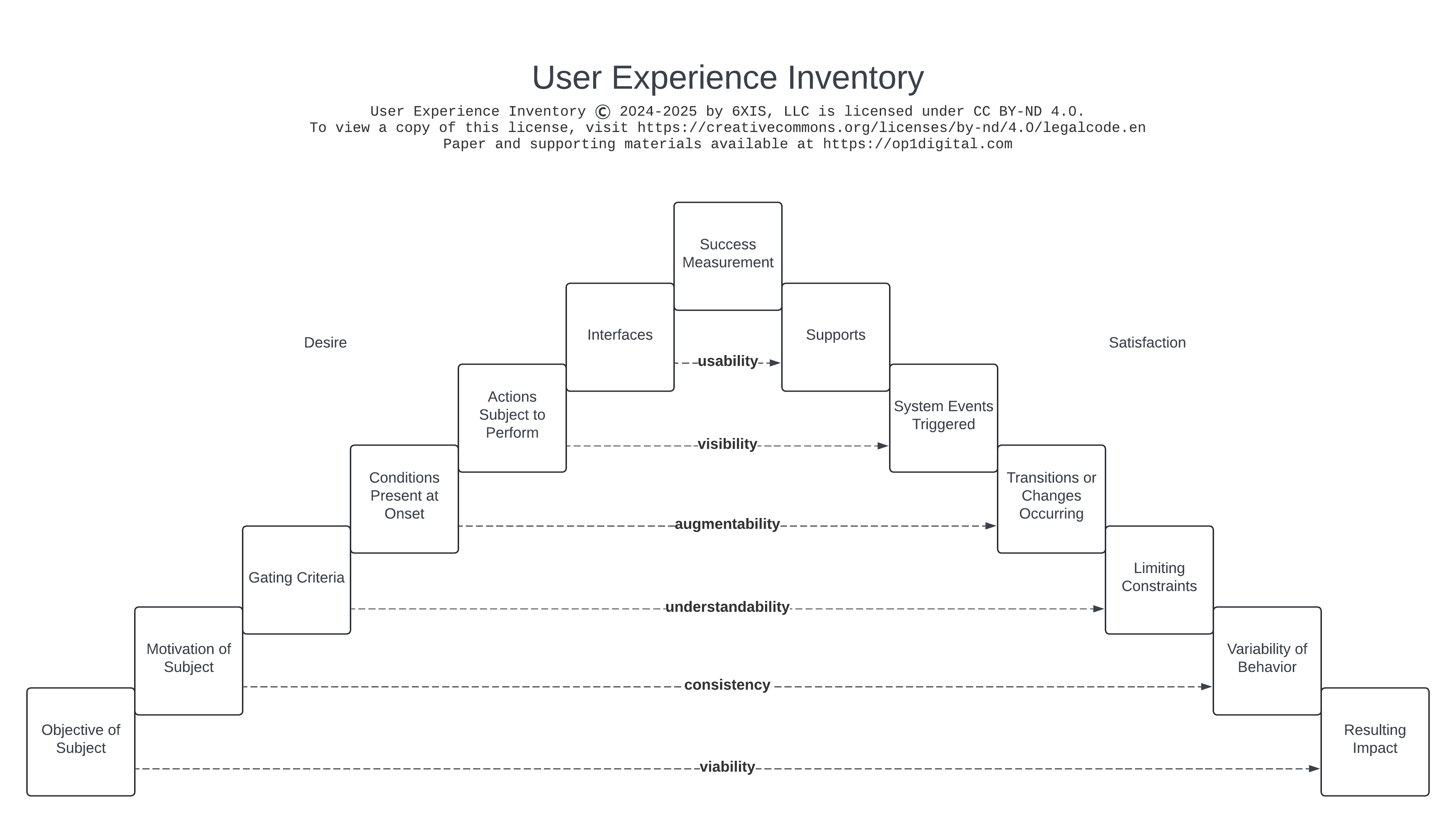Purpose
What does it do?
User Experience Inventory compares alignment between a user experience and user expectations.
User Experience Inventory can be used to build a complete picture of what someone wants to achieve, why they want to achieve it, what might stop them, and how their actions, tools, and conditions shape their experience so that we can identify gaps, misalignments, and improvements.
Cause
Why did we build this?
op1digital turns strategic plans into real-world results.
op1digital operates at the intersection of risk management, user experience, problem solving, systems design, and emerging technology. Our extensive strategic and operational experience positions our solutions as ready-to-implement and ready to tackle real-world problems.
Through our work in UX and risk management, we realized that most existing UX methods require interpretation based on experience and expertise to determine problem areas. We built User Experience Inventory to internally detect misalignment, shortening the path to problem identification.
Problem
What are we solving?
User experiences support a broad range of users, including a user who will access our website, a customer who wants to purchase goods or services we sell, an adversary we want to oppose, or an ally we want to encourage.
While many user experience methods generate strong visual artifacts which can help identify problem areas, these methods require an external process to identify areas of misalignment. These external processes often require both subjective and objective consideration, making it difficult to integrate AI to the process.
Most existing user experience methods cannot provide a unified view of both beneficial and adversarial user experiences, as are needed to consider the necessity and impacts of security features.
Impact
Why do we need to solve this?
Failure to understand the alignment between a user's experience and expectations can impact:
- The presence of biases that our user will undoubtedly be successful or unsuccessful
- Identification of gaps in our available information and understanding
- Our ability to form a view of whether a user will be successful with a current design or could become successful through changes to the design
- Our ability to form a view of where the user is likely to encounter impediments or barriers
- How we could change the experience to better support our objectives, which might align to increased success for beneficial users and decreased success for adversarial users
Solution
How do we solve this?
User Experience Inventory drives comparison of user experience to user expectation by:
- Populating a comprehensive inventory from user objective to resulting impact.
- Identifying misalignment in measurement, usability, visibility, augmentability, understandability, consistency, and viability.
- Identifying gaps in measurement, measurement source diversity, alignment of evidence, absolutism and conditionality, and fine-grained details.
The result of this process is a set of potential opportunities to better support our objectives.
Result
User Experience Inventory can be used at a macro level to understand a large-scale objective or at a small scale to understand a specific critical component of a large-scale objective.
User Experience Inventory can be used standalone to organize information or with other methods such as customer journey mapping, timelines, and structured analytic techniques.
User Experience Inventory does not enforce a timeline model of its own. When used with other methods, User Experience Inventory can be used across a whole timeline for summary or on each segment of a timeline for detail.
User Experience Inventory can be used to consider an existing or past experience or when forming a future experience.
User Experience Inventory supports examining or re-examining existing information or can help identify additional information to capture. If conditions change, User Experience Inventory can facilitate a consistent refresh of our understanding.
Technical Attributes
How does this solution align to your needs?
By design, User Experience Inventory exhibits:
- Beneficial or Adversarial Focus: While commonly applied to users and customers, User Experience Inventory can also be used to understand adversaries or allies, which is particularly valuable in security, risk mitigation, and control design.
- Organization: User Experience Inventory organizes critical factors such as objectives, motivations, actions, interfaces, constraints, and outcomes without imposing its own timeline model, enabling seamless integration with other methods (e.g., Customer Journey Mapping, Event Condition Timeline).
- Repeatability and Updateability: User Experience Inventory models can be updated iteratively as new details emerge, allowing ongoing refinement and a current, accurate representation of the experience landscape.
- Bias Resistance: By systematically considering success, failure, and partial success, User Experience Inventory resists survivorship bias, ensuring a balanced and realistic understanding of experiences.
- Gaps, Weaknesses, Unknowns Identification: User Experience Inventory uncovers gaps in understanding, accounts for variability and constraints, supports change risk management, and assists in identifying areas where additional information or action may be needed.
- Past/Present/Future and Small-Scale/Large-Scale Flexibility: User Experience Inventory can examine experiences in past, current, and future states, supporting both high-level (macro) understanding and detailed (micro) exploration of timeline segments.
- Human and AI Compatibility: User Experience Inventory is a modern approach, recognizing that work is done by humans, by AI, and by humans working with AI. User Experience Inventory includes detailed written descriptions and efficient JSON descriptions.
Visual Model
User Experience Inventory includes both detailed text descriptions and a visual model which can be useful for visualizations.

License
op1digital Suite for Problem Solvers™ components, including User
Experience Inventory, are licensed under:
CC BY-ND
4.0
Commercial license terms are available for parties unable to accept our standard license terms.
Availability
User Experience Inventory is available from op1digital.
The latest release of User Experience Inventory was made on:
Ready to implement? Access the technical guide.
Support
Paid support is available for practitioners implementing op1digital components.
Paid consulting is available if you would like us to help you form solutions to your specific problems.